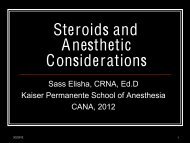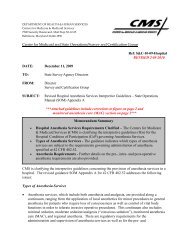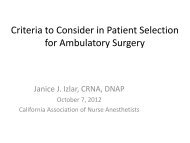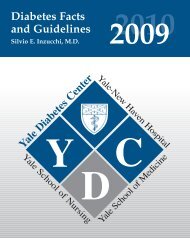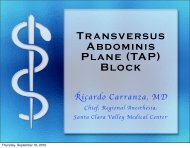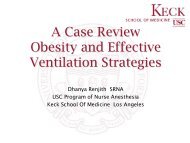Going into the Business of Anesthesia - Juan Quintana
Going into the Business of Anesthesia - Juan Quintana
Going into the Business of Anesthesia - Juan Quintana
You also want an ePaper? Increase the reach of your titles
YUMPU automatically turns print PDFs into web optimized ePapers that Google loves.
<strong>Going</strong> <strong>into</strong> <strong>the</strong><br />
<strong>Business</strong> <strong>of</strong> Anes<strong>the</strong>sia
... but Why<br />
For many, <strong>the</strong> attraction <strong>of</strong> setting up a<br />
business is <strong>the</strong> independence<br />
provided by being your own boss and<br />
<strong>the</strong> chance to have <strong>the</strong> lifestyle you<br />
want.
Traits <strong>of</strong> Successful Self<br />
• Motivated<br />
Starters<br />
• Not necessarily a “risk taker” - Controllable<br />
factors<br />
• Drive: responsibility, vigor, initiative,<br />
persistence<br />
• Thinking ability: original, creative, critical,<br />
analytical<br />
• Communications skills: verbal (expression<br />
and comprehension), written<br />
• Technical knowledge: comprehension <strong>of</strong> <strong>the</strong><br />
physical product services, utilization <strong>of</strong> <strong>the</strong><br />
information
Should I Start a <strong>Business</strong><br />
• What is your relevant experience and<br />
expertise<br />
• Is <strong>the</strong>re a market and how will you reach it<br />
• Who will be your main competitors<br />
• What makes you different<br />
• How will you fund your idea Does it make<br />
financial sense<br />
• What might go wrong<br />
Define Success.
What is a SUCCESSFUL<br />
anes<strong>the</strong>sia practice<br />
Meeting your priorities in life = success<br />
•Money<br />
•Practice Models/Practice Atmosphere<br />
• ACT<br />
• Group<br />
• Autonomous<br />
•Location<br />
•Time (<strong>Juan</strong>’s choice)
Successful Traits to Cultivate<br />
• Noticing <strong>the</strong> importance <strong>of</strong> people<br />
• Working effectively with a group<br />
• Paying attention to how you communicate<br />
• Being sensitive to o<strong>the</strong>rs<br />
• Working well with those in authority<br />
• Balancing <strong>the</strong> big picture with <strong>the</strong> details<br />
• Being aware <strong>of</strong> customer needs and learn to<br />
network<br />
Frankel, P. Jump-Start Your Career: How <strong>the</strong> "Strengths" That Got You<br />
Where You Are Today Can Hold You Back Tomorrow, published by<br />
Three Rivers Press).
Advantages<br />
• Independence and flexibility<br />
• Being your own boss can give you <strong>the</strong><br />
choice to work more convenient hours -<br />
such as working around your children's<br />
school hours and holidays<br />
• Lifestyle<br />
• Pay<strong>of</strong>f in financial terms<br />
http://www.businesslink.gov.uk
Disadvantages<br />
• Longer hours<br />
• Difficult to separate work and home life =<br />
extra demands on your family<br />
• Stress<br />
• Loss <strong>of</strong> perks such as pension plans,<br />
holiday pay and sick leave<br />
• Financial difficulties, especially at start up<br />
http://www.businesslink.gov.uk
What is a W2<br />
W-2<br />
Employer withholds and pays:<br />
Income taxes (required by <strong>the</strong> IRS)<br />
Federal Income Tax<br />
State Income Tax<br />
FICA<br />
Social Security<br />
Medicare<br />
Employer taxes:<br />
FICA (Social Security and Medicare)<br />
FUTA (Federal Unemployment Tax)<br />
SUI (State Unemployment Tax)
What is 1099<br />
1099-misc<br />
Individual paid on an Untaxed basis<br />
It is <strong>the</strong> responsibility <strong>of</strong> <strong>the</strong> individual to file and<br />
pay <strong>the</strong> appropriate taxes.
Independent Contractors<br />
Rules<br />
Work with several clients<br />
Role is to accomplish a final result<br />
Determines <strong>the</strong> best way to achieve result<br />
Defines <strong>the</strong> agreed upon "result" in contract<br />
Pays <strong>the</strong>ir own taxes and files required gov’t forms<br />
Obtains licenses as needed<br />
Social Security taxes IC’s sole responsibility<br />
Obtains his/her own benefits<br />
Can deduct business expenses from his/her<br />
income tax.
IRS<br />
How much control<br />
Three Main IRS Factors -20-Point Checklist<br />
1. How much control <strong>the</strong> employer has over<br />
<strong>the</strong> worker’s behavior and work results.<br />
(Who controls training, equipment, where<br />
and what time <strong>the</strong> person works)<br />
2. How much control <strong>the</strong> employer has over<br />
finances (Does <strong>the</strong> employer have primary<br />
control over pr<strong>of</strong>it or loss)<br />
3. What is <strong>the</strong> relationship between <strong>the</strong><br />
parties (Does <strong>the</strong> worker receive benefits<br />
Is it a long-term relationship)
So why 1099, contractors<br />
IRS<br />
Individuals responsible for paying<br />
his/her own taxes, etc., tend to take full<br />
advantage <strong>of</strong> any potential business<br />
deductions so that <strong>the</strong>y pay less in<br />
taxes.
How about employers<br />
Managers are trying to meet budget<br />
constraints.<br />
• Avoids <strong>the</strong> cost <strong>of</strong> employee benefits<br />
(healthcare)<br />
• Avoid taxes, etc. (13-19% pay)<br />
• Avoid restrictions to termination
Do I need to form a Corporation<br />
Alphabet Soup<br />
• Sole Proprietorship<br />
• LLC/PLLC<br />
• C corporation<br />
• Subchapter S<br />
Get a CPA or/and Attorney!!!<br />
http://www.smallbusinessadvantages.com/
Sole Proprietorship<br />
• A sole proprietor has total control,<br />
receives all pr<strong>of</strong>its from and is<br />
responsible for taxes and liabilities <strong>of</strong><br />
<strong>the</strong> business
Sole Proprietorship Advantages<br />
• Easiest and least expensive form <strong>of</strong><br />
ownership to organize<br />
• Sole proprietors are in complete control,<br />
and within <strong>the</strong> parameters <strong>of</strong> <strong>the</strong> law, may<br />
make decisions as <strong>the</strong>y see fit<br />
• Sole proprietors receive all income<br />
generated by <strong>the</strong> business<br />
• Pr<strong>of</strong>its from <strong>the</strong> business flow directly to<br />
<strong>the</strong> owner's personal tax return<br />
• The business is easy to dissolve, if desired
Sole Proprietorship<br />
Disadvantages<br />
• Sole proprietors have unlimited liability,<br />
legally responsible for all debts- business<br />
and personal assets are at risk<br />
• Disadvantage - raising funds, Difficulty<br />
motivating individuals to work with <strong>the</strong><br />
business<br />
• Some benefits such as owner's medical<br />
insurance premiums are not directly<br />
deductible from business income (only<br />
partially deductible as an adjustment to<br />
income).
LLC/PLLC<br />
A flexible enterprise blending<br />
elements <strong>of</strong> partnership and<br />
corporate structures. It is a legal<br />
form <strong>of</strong> company providing limited<br />
liability to it’s owners.<br />
FL - Articles <strong>of</strong> Organization (~$140/year)
LLC Advantages<br />
• Limited Liability - business debts<br />
• Pass-Through Taxation. Owners report<br />
pr<strong>of</strong>its/losses on personal tax returns<br />
• Citizenship- No requirement<br />
• Management Flexibility unlimited # <strong>of</strong> owners.<br />
• Simple Recordkeeping<br />
• Deductible Expenses<br />
• Flexible Pr<strong>of</strong>it & Loss Allocations LLC is not<br />
required to allocate pr<strong>of</strong>its and losses in proportion to<br />
ownership interest ("member interest')<br />
• Nationally Recognized
LLC Disadvantages<br />
• Earnings subject to self-employment<br />
tax<br />
• Incentive stock options not available<br />
• Investor uneasiness<br />
• Some states tax LLCs
Corporations<br />
• Legal entity - exists separately owners<br />
• Limits owners from personal liability<br />
• Taxes levied on corporation and<br />
shareholders<br />
• Sale <strong>of</strong> stocks or bonds can generate<br />
additional capital<br />
• Longevity <strong>of</strong> <strong>the</strong> corporation can<br />
continue past <strong>the</strong> death <strong>of</strong> <strong>the</strong> owners.
Corporation Advantages<br />
• Limited liability for debts or judgments<br />
• Accountable for your investment in stock <strong>of</strong><br />
<strong>the</strong> company<br />
• Raise additional funds via sale <strong>of</strong> stock<br />
• Cost <strong>of</strong> benefits to <strong>of</strong>ficers/employees<br />
deductible<br />
• Can elect S corporation status if<br />
requirements are met = taxed similar to a<br />
partnership
Corporation Disadvantages<br />
• Process <strong>of</strong> incorporation involves<br />
more time and money<br />
• Monitored by federal, state and some<br />
local agencies = more paperwork to<br />
comply with regulations<br />
• Incorporating may result in higher<br />
overall taxes. Dividends paid to<br />
shareholders are not deductible from<br />
business income; thus it can be taxed<br />
twice
Sub S Corporations<br />
• A tax election only; enables <strong>the</strong><br />
shareholder to treat earnings and<br />
pr<strong>of</strong>its as distributions and have <strong>the</strong>m<br />
pass through directly to <strong>the</strong>ir personal<br />
tax return. The catch, <strong>the</strong> shareholder<br />
working for <strong>the</strong> company + pr<strong>of</strong>its,<br />
must pay him/herself wages, and must<br />
meet standards <strong>of</strong> "reasonable<br />
compensation".
<strong>Business</strong> Plan<br />
• An unpublished study completed at<br />
Babson College by Lange et al. (2007)<br />
suggests that for those who are not<br />
seeking outside funding, having a<br />
formal business plan before start up or<br />
not having one really made no<br />
difference in <strong>the</strong> ultimate success <strong>of</strong><br />
<strong>the</strong> business.
Naming your business<br />
• Start by deciding what you want your name<br />
to communicate. Company name should<br />
reinforce <strong>the</strong> key elements <strong>of</strong> your business<br />
• The more your name communicates to<br />
consumers, <strong>the</strong> less effort you must exert to<br />
explain it<br />
• Search/Register your name<br />
http://www.entrepreneur.com/
The Pitch<br />
• Learn how to tell a good story<br />
• Develop a format that flows easily<br />
• Timing is everything: less than 15<br />
minutes<br />
• Provide contact information<br />
http://hubpages.com/hub/How_to_Pitch_Your_Small_<strong>Business</strong>_Idea_With<br />
_Success
Know Your Market<br />
• Will you market to businesses, to consumers,<br />
or to both<br />
• What are <strong>the</strong>ir traits<br />
• Is <strong>the</strong> need for your product or service not<br />
currently being met or is it already<br />
saturated<br />
• Is <strong>the</strong>re something that will allow you to beat<br />
your competitors<br />
http://homebusiness.about.com/od/getstarted/ss/10StepsB4_2.htm
Leg Work<br />
• Tax Id number<br />
• Corporate Veil - fact or myth<br />
• Company NPI number<br />
• Medicare<br />
• Medicaid<br />
• Private Insurance
Negotiating Contracts<br />
The real work starts here!!<br />
• Once you’ve established your company,<br />
you will need to negotiate a contract in<br />
order to work.<br />
• Research and experience are <strong>the</strong> great<br />
equalizers in contract negotiations.
Negotiation Basics<br />
Volumes <strong>of</strong> literature are available on <strong>the</strong><br />
art <strong>of</strong> negotiation.<br />
“Fearless Negotiating” by Michael C.<br />
Donaldson – easy to read,<br />
great start<br />
__________________<br />
• Wish – shoot big, frame it nicely<br />
• Want – your expected agreement point<br />
• Walk – issues that are unacceptable
Negotiations<br />
Recognize negotiations occur everyday<br />
• Patients<br />
• Physicians<br />
• Hospital Staff<br />
• Administrators<br />
(recognize your customers!!)
Tips<br />
• Figure out what you want: unless you're clear,<br />
chances are you won't get it<br />
• Ask for what you want<br />
• Realize you have something valuable<br />
• Written contracts are not set in stone<br />
• Listen/make compromises, Make it a "win-win"<br />
proposition<br />
• Learn to smell trouble<br />
• Learn from o<strong>the</strong>rs in your field<br />
• Get it in Writing<br />
• Learn how to say "No“. Be willing to walk away
Contracts<br />
Ingenuity wins<br />
Some examples<br />
• Fee for Service<br />
• Stipend – Flat fee<br />
• Income guarantees<br />
• Shared Contracts<br />
• Locums
Contract Writing<br />
• Establish your own “standard” contract<br />
• Use plain English<br />
• Cannot protect you from everything<br />
• Experience decreases traps<br />
• Get legal counsel to assure compliance<br />
with state laws
What am I worth<br />
"Success doesn't come to you... you go<br />
to it.”<br />
- Marva Collins –
Compensation<br />
Compensation varies (You determine <strong>the</strong><br />
bottom line)<br />
_________________________<br />
Compensation = Salary + time <strong>of</strong>f<br />
or<br />
Salary + benefits = Salary + ~30%Salary
Billing Anes<strong>the</strong>sia<br />
CRNAs/MDAs bill (utilizing – CMS 1510<br />
form)<br />
• Medicare<br />
• Anes<strong>the</strong>sia - billed Medicare part B<br />
• Hospitals bill<br />
• Medicaid<br />
• Inpatients Medicare part A<br />
• Outpatients Medicare part B<br />
• All o<strong>the</strong>r private insurers (BCBS, Aetna..)<br />
• Private pay/no pay
Payer Mix<br />
Payer Mix is <strong>the</strong> percentage <strong>of</strong> <strong>the</strong><br />
patients in each <strong>of</strong> <strong>the</strong> categories.<br />
This varies according to practice<br />
setting.<br />
e.g.<br />
70% Medicare<br />
20% Private Insurance<br />
5% Medicaid (OB = higher %)<br />
5% Private payer/no pay
Payer Mix<br />
Medicare<br />
Medicaid<br />
Private Pay<br />
Insured
Billing Medicare Part B<br />
Anes<strong>the</strong>sia is billed: base unit + TM (time<br />
units). TOS 7<br />
• Relative Value Guide – Published by <strong>the</strong> ASA<br />
establishes <strong>the</strong> CPT codes and base units for<br />
each procedure (also Crosswalk)<br />
Anes<strong>the</strong>sia for procedures: Central lines,<br />
Pain Procedures etc… base units only<br />
(no time component) TOS 2
Billing Base Units + TM<br />
Relative Value Guide is divided <strong>into</strong><br />
anatomical sections:<br />
E.g..<br />
• Lower Abdomen<br />
•00832 Ventral / Incisional Hernias<br />
•6 base units + time<br />
•Time = 1unit/Q15min (usually)<br />
Note: No differentiation for type <strong>of</strong> anes<strong>the</strong>tic
Example bill – Medicare<br />
Ventral Hernia<br />
Patient Case: 68 y.o. male with ventral<br />
hernia. - smoker, HTN<br />
Procedure takes 1 hour<br />
Medicare coverage<br />
Conversion Factor (CF) ~$21.00/unit
Example bill - Medicare<br />
continued<br />
00832 Ventral Hernia<br />
6 base units + 1hr (4units) = 10units<br />
10 units x $21.00/units = $210.00<br />
(Medicare pays 80% = $168.00)<br />
(Patient pays 20% = $42.00)
Your Billable $$$$<br />
In <strong>the</strong> previous case a total <strong>of</strong> $210.00 were<br />
generated for an hour case<br />
Medicare!!<br />
30min turn around time + 30min lunch<br />
+ x2 15min breaks<br />
Can do 5 anes<strong>the</strong>tics/day<br />
5 x $210 = $1050 (generated)/day
Billing Private Insured<br />
Ventral Hernia<br />
00832 Ventral Hernia<br />
6 base units + 1hr (4units) = 10units<br />
______________________________________<br />
East Coast - CF range $30.00-$95.00/unit<br />
Median $55.00<br />
______________________________________<br />
10 units x $55.00/unit = $550.00<br />
For a 1hr case!!!<br />
Fees Paid for Anes<strong>the</strong>sia Services: 2007 Survey Results<br />
Karin Bierstein, J.D., M.P.H. Associate Director <strong>of</strong> Pr<strong>of</strong>essional<br />
Affairs
Average Daily<br />
Generated Income<br />
Consider 5 elective cases<br />
4 medicare/1 privately insured<br />
_____________________________<br />
Payer Mix = 70% Medicare<br />
20% Pvt. Insured<br />
4 cases x $210/case = $840.00<br />
1 case x $550/case = $550.00<br />
Total = $1390.00/day
Average Weekly/Yearly<br />
Averaging $1390/day x 5 days/week<br />
$6950.00<br />
(consider 5 weeks <strong>of</strong>f a year)<br />
52 weeks/year – 5 weeks = 47 weeks<br />
__________________________<br />
$6950.00 x 47weeks =<br />
$326,650.00/year<br />
avg. CRNA income :O)
Anes<strong>the</strong>sia Practice Models -<br />
Choosing a model<br />
Anes<strong>the</strong>sia Care Team (ACT) – medically<br />
directed model<br />
Anes<strong>the</strong>sia Care Team – supervised<br />
model<br />
Groups – may have CRNAs only, MDAs<br />
only or CRNA/MDA “consultation” all<br />
paying <strong>into</strong> one account<br />
Solo practices
Medical Direction is a choice!!<br />
Utilization <strong>of</strong> <strong>the</strong> medical direction model<br />
is a choice…<br />
A poor choice, never<strong>the</strong>less a<br />
choice.<br />
Let’s figure out why.
ACT – Medically Directed<br />
Anes<strong>the</strong>sia model in which <strong>the</strong> MDA (1)<br />
medically directs concurrent (2-4max) CRNAs<br />
________________________________________<br />
1 MDA bills QK, meets TEFRA rules, gets<br />
reimbursed 50% <strong>of</strong> each case- $190/2 = $95<br />
$95 x 4 cases = $380/hr<br />
4 CRNAs bills QX, gets reimbursed 50% <strong>of</strong><br />
<strong>the</strong> case - $95/hr - each
ACT – supervision model<br />
ACT model in which <strong>the</strong> MDA supervises<br />
more than 4 concurrent procedures.<br />
MDA bills AD, gets 3units/case, 1<br />
additional unit if available for induction<br />
Leaves $$$ on <strong>the</strong> table<br />
3-4 possible units billed
ACT supervision model<br />
MDA billing AD<br />
e.g. – Medicare case<br />
MDA - Could have billed 5 units will only bill 4.<br />
4 units ($19.00/unit) = $76.00/case<br />
8 cases x $76.00 = $608/hr<br />
Could have billed with 2 MDAs $760/hr or by<br />
allowing CRNAs to bill QZ - $760/hr<br />
CRNAs still bill QX, 50% or $95/hr
Group (collaborative)<br />
Model/Solo Model<br />
Each provider bills utilizing <strong>the</strong>ir own<br />
modifier. 100% reimbursed /case, No<br />
additional rules to follow.<br />
MDA = AA<br />
CRNA = QZ<br />
Best possible system with least potential<br />
for fraud r/t TEFRA rules. 100% billed<br />
with 100% potential reimbursement
Back to Choices<br />
Referencing <strong>the</strong> different billing models:<br />
ACT – medical direction -100%/case<br />
ACT – supervision - < 100%/case<br />
Group (collaborative)/Solo - 100%/case<br />
Avoid ACT supervision billing model to<br />
optimize reimbursement
TEFRA FRAUD<br />
• Outpatient Surgery Magazine<br />
• December 2007<br />
• Jay Horowitz CRNA /Lou Stanfield Phd CRNA<br />
• January 2008<br />
• Barry Cranfill CRNA MBA<br />
www.outpatientsurgery.net
Back to Choices<br />
2 Models remain<br />
Group (collaborative) model billing 100%<br />
ACT model + TEFRA /medically directed<br />
100% <strong>of</strong> available reimbursement<br />
MDAs – group employed (hospital employed<br />
rare – teaching facilities, company model)<br />
CRNAs – group employed<br />
CRNAs – Hospital employed
Back to choices<br />
MDAs and CRNAs in <strong>the</strong> same group =<br />
$$$$ go <strong>into</strong> <strong>the</strong> same account.<br />
Salaries are determined by <strong>the</strong> Group.<br />
Each case is billed 100% <strong>of</strong> it’s<br />
potential reimbursement, no TEFRA<br />
rules are broken, even accidentally.
Problematic Choices<br />
MDAs work for <strong>the</strong> group, while CRNAs work<br />
for <strong>the</strong> facility<br />
• TEFRA is onerous for <strong>the</strong> MDA, BUT…. <strong>the</strong>y bill<br />
an extra 100%.<br />
The facility pays for CRNAs - gets 50% on<br />
Medicare patients / some private insurance.<br />
Serves as an additional stipend for <strong>the</strong> MDAs<br />
• In some instances private insurance Co. do not<br />
split bill (QK,QX) so <strong>the</strong> MDA group gets <strong>the</strong><br />
entire amount, <strong>the</strong> facility gets- nutin’ (0).
Problematic choices<br />
MDAs work for <strong>the</strong> Group, CRNAs work<br />
for <strong>the</strong> facility.<br />
The facility absorbs all CRNA cost with<br />
1/2 <strong>the</strong> reimbursement<br />
Add Stipends!!<br />
Result - Facilities seek alternatives to <strong>the</strong><br />
current anes<strong>the</strong>sia practice model
Summary<br />
You define Success.<br />
Form a corporation that reflects your needs<br />
Negotiate – Wish, Want, Walk<br />
Contracts – Be creative, Be careful<br />
Know your worth /How to bill it.<br />
Encourage utilization <strong>of</strong> Practice Models that<br />
optimize reimbursement w/o all <strong>the</strong> traps
Sleepy Anes<strong>the</strong>sia Associates<br />
PLLC<br />
<strong>Juan</strong> F. <strong>Quintana</strong> CRNA, DNP<br />
a_sleeper2@yahoo.com




